I love that name, Running Pines, so it takes me a minute to recall the real name of these forest-dwelling plants. It’s not a misnomer though, they really do look like little pine trees running through the forest.
And when I say little trees, I mean miniature ones.
Running Pines are a type of Club Moss, which are more closely related to ferns than flowering plants. They reach less than a foot tall. Maybe 6 or 8 inches tall.
We can find two kinds of running pines on our mountain ridge. One kind looks like miniature Christmas trees and the other looks like tiny flat cedars. The Christmas tree type is called Tree Clubmoss, Lycopodium obscurum, and the flat cedars are known as Ground Cedars, L. tristachyum.
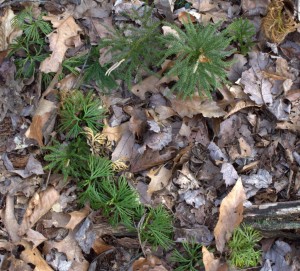
Although both species are included in the above photo (tree clubmoss is on the top right and ground cedars are on the left), it’s more usual to find them in separate colonies.
We have at least four of the tree clubmoss groups and two of the ground cedars on the mountain ridge.
In early Spring the running pines are well on their way to propagating the next generation. Looking across a colonial mass of these small plants you can see the yellow tops that are the reproductive structures.
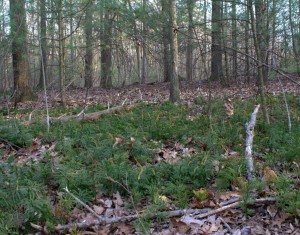
Not flowers with pollen, but other structures for reproduction that are common to all the Club Mosses.
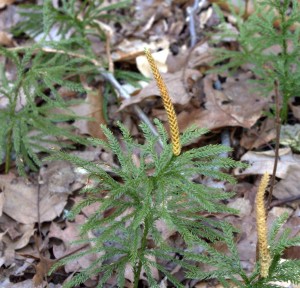
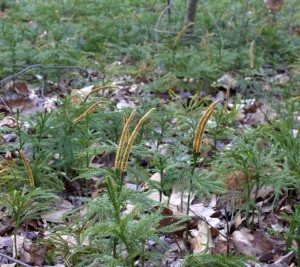
Tree clubmosses most often sport a single strobilus — the long yellow top that may grow straight up or curve to one side and which houses the spore cells used for propagation — less often there will be two or three strobili.
A whole colony can be seen from down the trail, especially at this time of the year when the trees haven’t leafed in yet. When there’s a lot more green in the forest it’s harder to see the whole colony unless you’re right up on it.

I say colony because the clubmosses appear to be many individuals growing in a tight formation.
Each little tree springs up from an underground stem or rhizome so many of the aerial parts we see are actually connected together underground.
Since most of the propagation takes place vegetatively, not sexually, a colony is probably a large, single organism.
Sexual reproduction does occur in the club moss, but conditions have to be just right and apparently that’s a rare thing. It may take more than a decade for sexual reproduction to lead to the development of a new individual. Therefore, most of the new clubmosses we see can be assumed to come from vegetative budding from rhizomes or runners…and that leads us to the common name for the clubmosses, running pines!
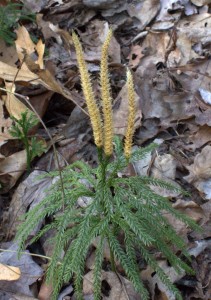
Note the small new Christmas tree clubmoss on the left in this image. Vegetative reproduction is happening.
(Photos taken 8 March 2016. Click on any small image to see a larger view.)
At first look it seems that the ground cedars will send up their strobili a little later in the season, but the few observed near the tree clubmoss colony pictured is too small a sample to make conclusions. Stay tuned!